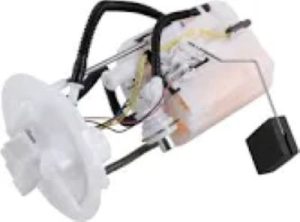In the case of a fuel-injected car, the fuel pump does its job in feeding a necessary amount of gas to engine under correct pressure. Fuel flows through the line and into the fuel pump (the process starts in the fuel tank, where it will actually be). The pump pulls fuel from the tank and sends it along fuel lines to the injectors. The fuel injectors next squirt globs of gasoline into the combustion chamber in just the right amounts to make the mixture ignite and burn perfectly, with just the right amount of power produced. With modern engines, even some running on carburetors must be fed at high pressure these days—generally between 40 and 70 psi (pounds per square inch)—so that pump must to able to cope with the task of delivery.
The fuel pump is operated by the engine control unit (ECU) of your vehicle, which in turn reads engine speed, load and throttle position. The ECU then operates the pump to provide whatever fuel flow the inputs suggest is required. The higher precision this control provides is essential since it helps with managing the air-fuel ratio which determines fuel efficiency and emissions. Fuel pumps have become a key part of modern engine management systems as even minor changes in fuel pressure can improve fuel efficiency by up to 10%, according to data gathered by the International Council on Clean Transportation for a report published in 2019.
Fuel pumps for fuel-injected carsThere are two basic styles of electric fuel pump used in fuel injection cars. At least some part of the pump sits inside the fuel tank which makes in-tank pumps from 1990s-on outdated vehicle more common nowadays, much because they're operationally superior as well as it's better for it to be collected and cool by the surrounding fuel. External pumps are commonly used in high performance or modified vehicles that require higher flow rates of fuel. The fuel pump, regardless of the type is needed to work uniformly and dependably to prevent a number of carriage performance issues like stalling, misfire or hard starting.

EfficiencyThe main part of the work done by a fuel pump is to operate in the most efficient manner possible. The pump must be able to maintain constant adequate fuel flow even at high engine speeds. If the fuel pump is faulty or not working properly entirely, this can eventually lead to a case of fuel starvation, where the flow of gasoline to the engine completely stops; preventing your vehicle from running. This can lead to symptoms such as the engine running too lean if the fuel pump cannot maintain proper pressure and ultimately result in overheating or premature wear of other engine components.
If the fuel filter is clogged, it can prevent enough fuel flow to keep the pump cool, causing lack of lubrication to the motor. Changing the fuel filter, often every 30,000-40,000 miles is essential to keep your pump gerate. In 2020, Consumer Reports published a report emphasizing the importance of fuel system maintenance and citing prices for fuel pump replacements ranging from $400 to $600 as per the vehicle manufacturer.
"Basic principles of fuel delivery are the same even with most advanced engines," as famously said by Tesla CEO Elon Musk. That is certainly true of items such as the fuel pump, which must perform reliably with not only modern-day engines but also new engine technology.
So in short, the fuel pump on a fuel injection vehicle guarantees that the engine gets fuel under as much pressure as it needs to deliver peak performance. For additional information, please visit Fuel Pump; how to keep your fuel pump running or how to replace it.

